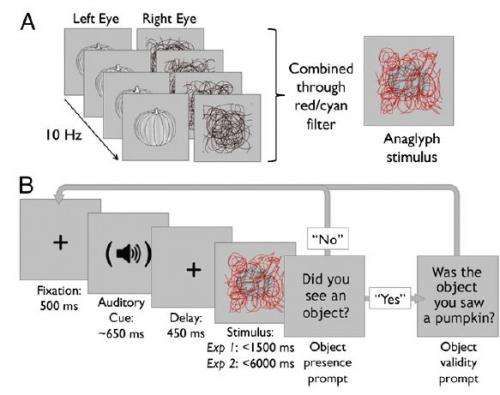August 13, 2013 report
Study shows language can cause the invisible to be seen

(Medical Xpress)—Researchers Gary Lupyan and Emily Ward from the University of Wisconsin and Yale respectively, have run experiments that show that in some instances, language can cause objects that are obscured from view, to come into focus. In their paper published in Proceedings of the National Academy of Sciences, the team describes experiments they conducted that contradict the notion that vision and language processing are separated in the brain.
In the never ending process of attempting to understand how the human brain works, researchers have separated out certain components to see how the others respond. In other experiments, they have tried bombarding the senses to see how the brain reacts. In this latest effort, the researchers took the latter approach.
To ascertain if the brain has different processing sections for the different senses, e.g. vision, hearing, tasting, etc. the researchers used continuous flash suppression. This is where a picture of an object is shown to one eye while the other eye is bombarded with a flashing image of tangled lines. Prior research has shown that the flashing imagery causes the brain to completely ignore the image that is being shown to the other eye. The researchers sought to learn whether this result could be changed if another sense was added—that of hearing recognizable words.
To short-circuit the continuous flash suppression effect, the researchers played recorded verbal cues that either did or did not have some connection to the image that was being displayed in the other eye—offering the word "circle" for example, if the image was indeed that of a circle.
That was really all it took. When the researchers offered valid clues, the volunteers in the experiment began reporting being able to see the image being shown to one eye, despite being flashed in the other. In contrast, when given words that were not related to what was being shown, the volunteers were still not able to see the image right in front of their eye. This, the researchers contend, suggests that the brain does not separate processing of input information by type. Instead, it appears clear that there is some overlap. They suggest that the word cue causes the brain to "get ready" for what is to come next. If what was advertised does show, then the brain is ready to see it, despite the distraction offered to the other eye. If it doesn't, then the distraction overwhelms the senses causing the image to be ignored.
More information: Language can boost otherwise unseen objects into visual awareness, PNAS, Published online before print August 12, 2013, DOI: 10.1073/pnas.1303312110
Abstract
Linguistic labels (e.g., "chair") seem to activate visual properties of the objects to which they refer. Here we investigated whether language-based activation of visual representations can affect the ability to simply detect the presence of an object. We used continuous flash suppression to suppress visual awareness of familiar objects while they were continuously presented to one eye. Participants made simple detection decisions, indicating whether they saw any image. Hearing a verbal label before the simple detection task changed performance relative to an uninformative cue baseline. Valid labels improved performance relative to no-label baseline trials. Invalid labels decreased performance. Labels affected both sensitivity (d?) and response times. In addition, we found that the effectiveness of labels varied predictably as a function of the match between the shape of the stimulus and the shape denoted by the label. Together, the findings suggest that facilitated detection of invisible objects due to language occurs at a perceptual rather than semantic locus. We hypothesize that when information associated with verbal labels matches stimulus-driven activity, language can provide a boost to perception, propelling an otherwise invisible image into awareness.
© 2013 Medical Xpress
















